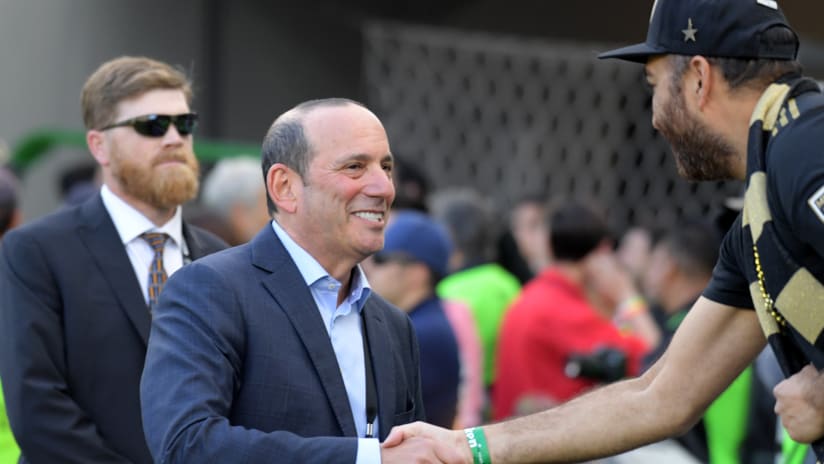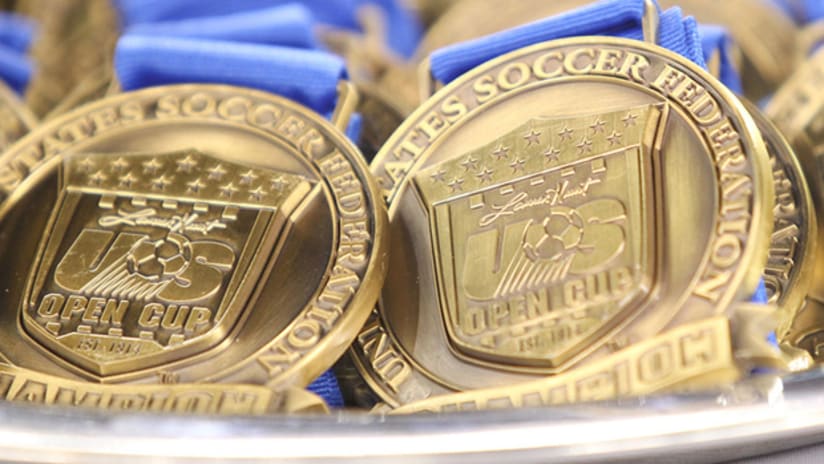MLS Commissioner Don Garber spoke to local and national media Tuesday at Pinnacle, the new, world-class training home of Sporting Kansas City. Below is a transcript of Commissioner Garber's remarks.
His initial thoughts on Pinnacle…
I’ve spent the last couple of hours here, and I’m just completely blown away. We now have 20 (soccer-specific training) facilities for our clubs, and to think of where we were as a league just within the last couple of years, it’s nearly half a billion dollars of investment. When I walk through this facility — and having walked through Manchester City and AC Milan and Barcelona and Arsenal — I see levels of performance, attention to detail and branding, levels of connection with our federation. And (at Pinnacle) I think we’re operating best-in-class. Hopefully it pays off over time for our club here in Sporting Kansas City, but also for our national teams.
On the importance of having world-class facilities like Pinnacle…
It is incredibly important for so many different reasons. It’s not just the actual value that it provides our team. It really elevates what Major League Soccer is all about. When you have this kind of investment and this public/private partnership, which is a great model for other states in the U.S. and other provinces in Canada, it shows the significance of Major League Soccer in what we mean and what we aspire to be.
In this particular facility, (Sporting KC Manager) Peter Vermes walks around with (Sporting KC co-owners) Mike and Cliff Illig with such a deep emotional commitment to what this facility represents for Sporting Kansas City. How do they approach performance? How do they differentiate themselves from other clubs? How do they come up with a strategy for their team that is different from other clubs that gives them a point of difference? So if I was a player from anywhere around the world, or if a U.S. player has an opportunity to play in any market, had I come through this facility with Peter and his coaching staff, I can’t imagine that it wouldn’t be incredibly enticing for me to want to play for this team. That has enormous value, but keeping players healthy, having them perform at a high level, having them represent the club brand and represent the city and the state—that’s going to pay great dividends for everybody.
On the correlation between the quality of facilities and the quality of play on the field…
This is the beginning of a long process, and you need to have the resources to be able to develop facilities like this. Not just what they are in bricks and mortar, but what they represent in terms of strategy and approach. There’s no doubt that if you get a chance to walk through (Pinnacle) from start to finish, you will absolutely be convinced that it’s going to make Sporting KC a better team. Ultimately the coaching component with U.S. Soccer will also help our national team get better. You have to have good teachers to be able to have good, high-quality students. We’ve got to start somewhere, and I think this partnership and facility with U.S. Soccer is a great place to get the ball rolling.
On Pinnacle’s features and amenities…
A lot of the medical evaluation and medical performance approaches to recovery give this team a point of difference on the field. When you have an owner who comes from the healthcare industry, you can understand where that comes from. Having a partnership with Children’s Mercy also gets you there. I’ve never seen anything like it in any facility that I’ve been through, so I think you all would be pretty astounded by it. It is a little bit of their secret sauce — every team has got to have a differentiation from their competitors, it can’t be just what you spend and how lucky you are with injuries or how lucky you are with ball bounces. It really has to start from within. And I think that’s very much the ethos of this club and the way they are approaching everything, from their facilities to their brand to their relationship with the community.
On the importance of developing of soccer-specific training facilities…
I’m probably more impressed by facilities like this, where clubs are putting bricks and mortar in the ground that are not just about delivering a fan experience — which is super important — but about delivering an experience to players that will help them be more competitive. We want to be one of the more significant major leagues in North America, and as a vision we want to be one of the top soccer leagues in the world. We’re going to have to operate with that American way of dealing with technology and delivering a product where we’re capturing all of the strategy that we can.
On the goal of MLS becoming a top soccer league in the world…
You have to have timetables. When we were bidding to host the World Cup in 2022, and that bid was in Zurich in 2010, we (said) we wanted to be one of the top leagues in the world by 2022. We are getting pretty darn close to 2022, so it’s still our goal. It’s not to be as good as England. When people think about the top soccer leagues and making a league like MLS their league of choice, that’s the ultimate measure we’re looking for. So when a player is deciding whether to play in Italy or Spain or Germany or England or Mexico, we want them to think about Major League Soccer. And we’re seeing more and more of that, particularly with some of the signings this year. We’re getting there.
On Sporting KC serving as a model franchise for expansion teams…
I’ve said many, many times that where we were (in Kansas City) many years ago, there was a question as to whether this sport and Major League Soccer would survive in Kansas City. Here we are today where Kansas City is best in class in so many aspects of the club. And in a market that is a relatively small market, to have the size of their fan base and the number of sold out games and the state-of-the-art facilities — and to have a team that has been competitive with other clubs for the last number of years with a terrific technical director and coach in Peter Vermes — it very much is a model. Before they closed their deal, the (Miami ownership group) spent a day or two with Cliff (Illig) and Peter (Vermes) touring this facility before it was fully completed. They’ve done a lot of things really well here.
On the momentum MLS has going forward…
I’m never comfortable with anything. I don’t think you can do what I do, which is manage an evolving business, and be comfortable. The minute you’re comfortable is the minute you have to pass the baton to someone else. We feel pretty good about the momentum we’ve been able to capture over the last couple of years. The league’s metrics are going up — our attendance, our television ratings, our fan base is growing, our investment in the league is at an all-time high, and our expansion interest is significant. We will be at 28 teams at some point and finalize the last remaining clubs. Overall we feel pretty good, but we’re still in the beginning chapters of what is hopefully going to be a very long book. I’m not looking (back) at what we’ve achieved. We’ve just got to keep our heads down and continue to be focused, building this sport from top to bottom and bottom to top, and ultimately, we should be OK.
On the positive impact of Targeted Allocation Money on MLS…
We were basically saying, “We want to put more money into our rosters to be able to have our clubs determine how to use those funds to improve the middle of their rosters. The mechanism is a good mechanism in this single entity that we have, and the ability to manage these kinds of decisions centrally was a way to effectively deliver that, similar to how we did the Designated Player rule many years ago. If we need to evolve it and put more money in or reallocate it, we can sit down as a group and figure that out. But I think the performance of the Concacaf Champions League this year was directly related to the influx of TAM and discretionary TAM money over the last year. And I think you’re only going to see more improvement.




